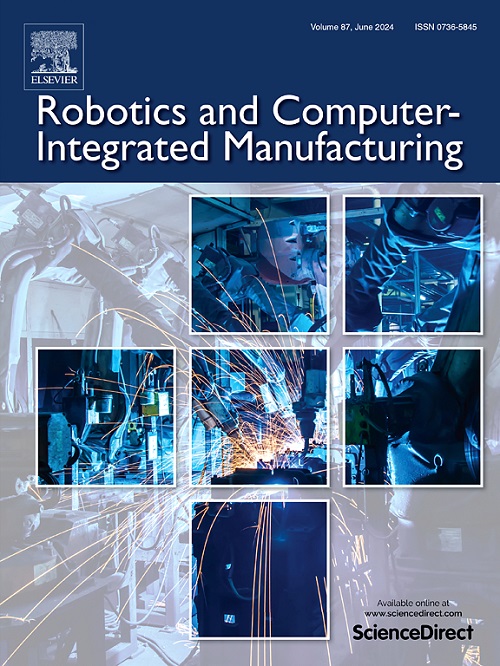LLM based autonomous agent of human-robot collaboration for aerospace wire harnessing assembly
IF 11.4
1区 计算机科学
Q1 COMPUTER SCIENCE, INTERDISCIPLINARY APPLICATIONS
引用次数: 0
Abstract
The fusion of large language models (LLMs) and robotic system bring transformative potential to human-robot collaboration (HRC). Existing LLMs-based HRC methods mainly realize on fine-tune techniques, which has the shortcomings such as damage of the inherent ability of original LLMs, difficulty performing complex continuous task, less flexibility, fixed response strategy and computationally expensive. Alternatively, the development paradigm of LLM applications is transiting towards the autonomous agent mode. This paper proposed an interesting LLM agent based HRC framework (or HRC agent), which empowers the robot with human’s think mode and execution ability of sensing, interaction, self-reasoning, task planning and task execution. The chain-of-thought technique that generates a series of intermediate reasoning steps is adopted to improve the ability of LLMs to execute complex reasoning and task. Few-shot learning is used such that HRC agent can quickly learns new specific industry tasks by being provided a few examples. The reflection-based contextual memory mechanism enables HRC agent to have long term memory and continuous instruction understanding ability. A series of tools are developed and integrated into HRC agent, by which the capabilities of HRC agent can be easily expanded without much changing of the code framework. The functionality and effectiveness of HRC agent is validated in the aerospace wire harnessing assembly task, whose products has the characteristics of small diameter wires, complicated wire text, dense and tiny assembly holes, varying product batch size and customized production, and thus has high requirements for flexibility. The results show that the HRC agent is able to well understand the natural language instructions and give correct and effective response by chain-of-though, and subsequently, drive the robot to execute tasks correctly by calling tools.
基于LLM的航天线束装配人机协作自主代理
大语言模型(llm)与机器人系统的融合为人机协作(HRC)带来了变革潜力。现有的基于LLMs的HRC方法主要通过微调技术实现,存在破坏原有LLMs固有能力、难以执行复杂的连续任务、灵活性差、响应策略固定、计算量大等缺点。另外,LLM应用程序的开发范式正在向自主代理模式过渡。本文提出了一种有趣的基于LLM agent的HRC框架(或HRC agent),使机器人具有人类感知、交互、自推理、任务规划和任务执行的思维模式和执行能力。采用产生一系列中间推理步骤的思维链技术,提高llm执行复杂推理和任务的能力。使用了少量学习,这样HRC代理可以通过提供一些示例快速学习新的特定行业任务。基于反射的情境记忆机制使HRC代理具有长期记忆和连续指令理解能力。开发了一系列工具并集成到HRC代理中,可以在不改变代码框架的情况下方便地扩展HRC代理的功能。HRC剂的功能和有效性在航空航天线束装配任务中得到验证,该任务的产品具有线束直径小、线束文本复杂、装配孔密集微小、产品批量大小多变、定制化生产等特点,对柔性要求较高。结果表明,HRC智能体能够很好地理解自然语言指令,并通过chain-of-though给出正确有效的响应,随后通过调用工具驱动机器人正确执行任务。
本文章由计算机程序翻译,如有差异,请以英文原文为准。
求助全文
约1分钟内获得全文
求助全文
来源期刊
CiteScore
24.10
自引率
13.50%
发文量
160
审稿时长
50 days
期刊介绍:
The journal, Robotics and Computer-Integrated Manufacturing, focuses on sharing research applications that contribute to the development of new or enhanced robotics, manufacturing technologies, and innovative manufacturing strategies that are relevant to industry. Papers that combine theory and experimental validation are preferred, while review papers on current robotics and manufacturing issues are also considered. However, papers on traditional machining processes, modeling and simulation, supply chain management, and resource optimization are generally not within the scope of the journal, as there are more appropriate journals for these topics. Similarly, papers that are overly theoretical or mathematical will be directed to other suitable journals. The journal welcomes original papers in areas such as industrial robotics, human-robot collaboration in manufacturing, cloud-based manufacturing, cyber-physical production systems, big data analytics in manufacturing, smart mechatronics, machine learning, adaptive and sustainable manufacturing, and other fields involving unique manufacturing technologies.

 求助内容:
求助内容: 应助结果提醒方式:
应助结果提醒方式:


